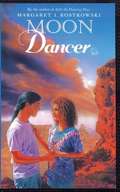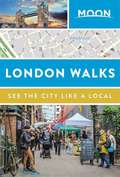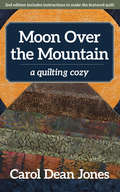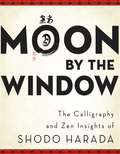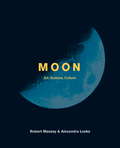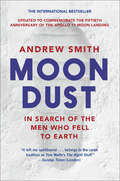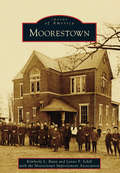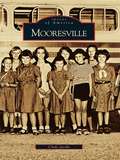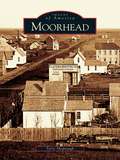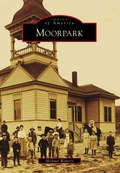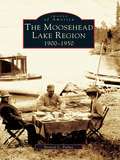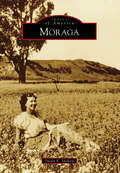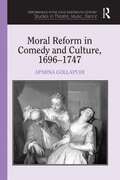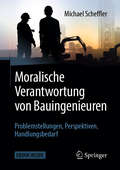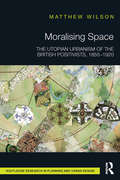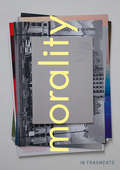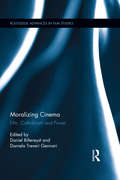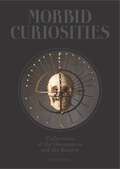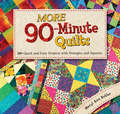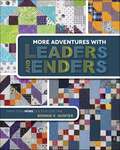- Table View
- List View
Moon Dancer
by Margaret I. RostkowskiSoon moonlight washed over everything. The houses and rocks around us and the cliff above sprang into detail in the bone white light. I hugged my knees and watched, leaning against Max, and without making a big deal about it, he put his arm around me. Then he stood up and pulled me up, too, then climbed down from the rock, signaling for me to follow. Once on the ground, he put both arms around my waist and waited until I reached up to put my arms on his shoulders. Then we began to dance, there in the moonlight, there with each other. We didn't say another word, just danced, held hands, and finally, slowly, carefully, kissed . . . then kissed again. I felt shot with silver, from the moon, from the dance, from Max.
Moon London Walks
by Moon Travel GuidesExperience London like a local: on foot! Whether you're shopping on the high street, strolling lively street markets, or admiring renowned modern art, discover London's highlights and local favorites with Moon London Walks. This full-color guide features: Six customizable walks through the city's hippest neighborhoods, including Shoreditch, Chelsea, Marylebone, and more, with color-coded stops and turn-by-turn directions; Foldout maps of each route and a removable full-city map, in a handy, portable guide; Curated "Top Ten" lists for restaurants, nightlife, markets, and Sunday activities; The top attractions and the best-kept local secrets: Head to Portobello Road Market to browse vintage treasures, or treat yourself at upscale department stores like Harrods. Make your way to the Tate Modern and other world-famous art galleries, take in London's history at Westminster Abbey, and watch the changing of the guards at Buckingham Palace. Take a leisurely stroll through Regent's Park, enjoy afternoon tea at a stylish hotel, or grab a pint and some fish and chips before heading to the theatre. Sip craft cocktails in an old train station, discover the hippest new gastropub, or watch the sun set over the city from a chic rooftop barPublic transportation options, including the underground, public buses, and taxis Practical tips for first-time visitors, including average costs, where you'll need to make a reservation, public holidays, and getting to and from the airport. With creative routes, public transit options, and a full-city map, you can explore London at your own pace, without missing a beat.
Moon Over the Mountain: A Quilting Cozy (A\quilting Cozy Ser. #6)
by Carol Dean JonesA quilting getaway in the Appalachians is overshadowed by danger in this mystery featuring bonus quilt instructions! After losing her husband, Sarah Miller has been trying to move on into a fulfilling new life, and the friends she&’s found at the Cunningham Village retirement community are a big help. And a tranquil quilting retreat in the Great Smoky Mountains will be a lovely getaway. But there&’s something alarming in the surrounding forest—and Sarah will soon have to turn her attention from threads to threats…
Moon Township
by Mark BertonAs one of the seven original townships of Allegheny County, Moon Township has a long and rich history. From the humble home of Joshua, John, and Jacob Meek in what is now Crescent Township to the Stoops House, owned by 19th-century riverboat captain William Stoops, today's Moon Township is a byproduct of these modest roots. Formed in 1788, Moon Township's history crosses borders into neighboring Findlay and Crescent Townships, which once comprised Moon. Today Moon Township is recognized as one of the most bustling and vibrant communities in the suburbs of Pittsburgh. Home to portions of Pittsburgh International Airport, a growing commercial corridor, and hundreds of new families each year, Moon Township is a major player in the future of western Pennsylvania. Through vintage photographs, Moon Township chronicles how this area has changed with the times while preserving as much of its history as possible.
Moon by the Window
by Shodo Harada Roshi Priscilla Daichi Storandt Jane Shotaku Lago Tim Jundo WilliamsShodo Harada is internationally recognized both as a Zen teacher and as a world-class master of the fine art of Zen calligraphy. Harada regularly exhibits and gives calligraphy demonstrations in museums and universities in the U.S. and abroad. Accomplished Zen teachers from across the globe come to further plumb the depths of Zen through studying with him, earning him a reputation as "the roshi's roshi" - which is to say, the master's master. Moon by the Window is a beautiful collection of 108 pieces of Shodo Harada's calligraphic Zen masterpieces - assembled over decades, and drawn from the rich and poetic literature of the Zen tradition. Each work of art is accompanied by Harada Roshi's sharp and glittering commentaries, making each page a spiritually edifying and aesthetically uplifting treasure.
Moon: Art, Science, Culture
by Robert Massey Alexandra LoskeA source of light in the dark of night and our ever-changing cosmic companion, the Moon has fascinated humankind since we first gazed into the sky. In this extensively illustrated and illuminating volume, art historian Alexandra Loske and astronomer Robert Massey present a rich and curious history. From its violent birth through to the exhilarating story of the Space Race and current exploration efforts, discover the many faces of the Moon and how they have shaped humanity's existence.
Moondust: In Search of the Men Who Fell to Earth
by Andrew SmithIn time for the 50th anniversary of the Apollo 11 moon landing comes this edition of journalist Andrew Smith’s Moondust, now updated with a new Afterword, that tells the fascinating story of twelve astronauts who ventured to space, and his interviews with nine of the surviving men.The Apollo lunar missions of the 1960s and 1970s have been called the last optimistic acts of the twentieth century. Twelve astronauts made this greatest of all journeys and were indelibly marked by it, for better or for worse. Journalist Andrew Smith tracks down the nine surviving members of this elite group to find their answers to the question "Where do you go after you've been to the Moon?"A thrilling blend of history, reportage, and memoir, Moondust rekindles the hopeful excitement of an incandescent hour in America's past when anything seemed possible as it captures the bittersweet heroism of those who risked everything to hurl themselves out of the known world—and who were never again quite able to accept its familiar bounds.
Moonlighting: An Oral History
by Scott RyanDiscover the real story behind the scenes of the 80s super-hit TV show Moonlighting, as cast and crew talk for the first time in this oral history that has &“all the delightful bounce and energy of Moonlighting,&” according to executive producer Jay Daniel."Scott Ryan Has compiled an amazing history of the show. I was there and honestly, I couldn't this down! Recommended!" - Curtis Armstrong (Herbert Voila) In the spring of 1987, over sixty million viewers tuned in to watch Maddie Hayes (Cybill Shepherd) and David Addison (Bruce Willis) &“get together&” in one of the most famously controversial scenes in television history on Moonlighting, ABC&’s groundbreaking series about an epically mismatched pair of private detectives . Two years later, the show was canceled due to low ratings. What happened? In Moonlighting: An Oral History, author Scott Ryan (The Last Days of Letterman) interviews over twenty members of the cast and creative team to get to the bottom of this perplexing mystery, uncovering hilarious, provocative, poignant, and sometimes flat-out crazy never-before-told stories about what went on behind the scenes during production of this unforgettable series. Cybill Shepherd, Allyce Beasley, Curtis Armstrong, creator Glenn Gordon Caron, producer Jay Daniel, writers, directors, editors, and more—they&’re all here, piecing together the incredible story of late scripts, backstage fights, pregnancies, and broken bones, all told for the first time. Enjoy the cases, the chases, and all the conversations in Moonlighting: An Oral History. The real story of this pioneering television series and the extraordinary behind-the-scenes challenges, battles, and rewards has never been told — until now. Author Scott Ryan (The Last Days of Letterman, thirtysomething at thirty: an oral history, The Last Decade of Cinema Massillon Against the World) interviews over twenty people, including the actors, writers, directors, and producers who made Moonlightingsuch a dynamic, unforgettable show, delving deep into their thoughts and feelings as they relive this magical moment in pop culture history in this full color oral history.
Moonshots and Snapshots of Project Apollo: A Rare Photographic History
by John Bisney J. L. PickeringWinner of the Bronze Medal for Science in the 2016 Independent Publisher (IPPY) Book AwardsIn this companion volume to John Bisney and J. L. Pickering&’s extraordinary book of rare photographs from the Mercury and Gemini missions, the authors now present the rest of the Golden Age of US manned space flight with a photographic history of Project Apollo.Beginning in 1967, Moonshots and Snapshots of Project Apollo chronicles the program&’s twelve missions and its two follow-ons, Skylab and the Apollo-Soyuz Test Project. The authors draw from rarely seen NASA, industry, and news media images, taking readers to the Moon, on months-long odysseys above Earth, and finally on the first international manned space flight in 1975.The book pairs many previously unpublished images from Pickering&’s unmatched collection of Cold War–era space photographs with extended captions—identifying many NASA, military, and contract workers and participants for the first time—to provide comprehensive background information about the exciting climax and conclusion of the Space Race.
Moorestown (Images of America)
by Moorestown Improvement Association Kimberly L. Bunn Lynne F. SchillSettled in 1682 by Quakers, Moorestown grew quickly into an important agricultural and social hub. Local farms and nurseries were considered the best in the state with their superior produce and specimen plants, and the coming of the railroad in the 1860s brought industrial leaders who helped the town to grow and prosper beyond its agrarian roots. It became the home of Eldridge R. Johnson, cofounder of the Victor Talking Machine Company, and Alice Paul, a women's suffrage champion. Moorestown provided easy access to New York City and surrounding urban centers, and it continued to be a mix of sought-after residential neighborhoods, working farms, and thriving businesses. Since 1904, the Moorestown Improvement Association has been instrumental in the town's growth, with contributions including funding the first artesian well, purchasing land for the first parks and athletic fields, and registering the town in the National Register of Historic Places.
Mooresville
by Cindy JacobsIt was a hot afternoon in August 1856 when people in southern Iredell County, North Carolina, gathered for a special event. The train was on its way, bringing officials, a brass band, and the economic future. John Franklin Moore viewed the railroad tracks as an opportunity to fulfill his dream of starting a community and building a town. He knew that trains would bring customers and new citizens and carry freight to and from markets. Moore took a bold step by providing land for a depot and siding and offering land for homes and businesses. Moore's Siding prospered and grew, and in 1873, the village was incorporated and named Mooresville to honor the founder. Generations of Mooresville citizens have taken daring steps into the future, building a community that is more than just a place--it's a home. This is a story of Mooresville, the Queen of Iredell.
Moorhead
by Terry ShoptaughMoorhead, Minnesota, was founded in 1872 as a major stop on the Northern Pacific Railroad during its push toward the Pacific Ocean. The town grew to prominence in western Minnesota because of its location at the intersection of the rail line and the commercially important Red River of the North. Garnering an unenviable reputation in its early years as a wide-open town, dominated by its saloons, Moorhead subsequently developed as an important rural service center. Tracing the history of Moorhead from its founding in 1872 to the present day, the images in this volume reveal the experiences of this small Midwestern community within a framework of change and continuity.
Moorpark (Images of America)
by Michael WintersThe story of Moorpark begins with a town that was built in the right place at the right time. In the 1890s, when the Southern Pacific Railroad announced plans to relocate its Coast Line through Chatsworth to Ventura, land speculation ensued. Robert W. Poindexter, secretary of the Simi Land and Water Company, owned the plot of land that became Moorpark and laid out the townsite in 1900. A depot was quickly built, and soon, trains were arriving daily. Shortly thereafter, an application for a post office was also approved. After the completion of the Santa Susana tunnels in 1904, Moorpark began to grow. Historically, Moorpark's main source of revenue has been agriculture. Initially, dry land farming, including apricots, was preferred. As irrigation techniques improved, walnuts and citrus became the major crops. Its extensive apricot production endowed Moorpark with the title "Apricot Capital of the World." After World War II, the poultry industry became big business, with turkey, chicken, and egg ranches dotting the landscape.
Moosehead Lake Region 1900-1950, The: 1900-1950 (Images of America)
by Everett L. ParkerThe Moosehead Lake region has long been a place where travelers go to escape. In the first half of the twentieth century, the region became a mecca for hunters and fishermen, as well as for travelers looking for rest and relaxation at popular resorts such as the Mount Kineo House. The Moosehead Lake Region: 1900-1950 uses vintage photographs to tell the story of this Maine retreat. The images depict visitors and residents of Greenville, Shirley, Rockwood, Beaver Cove, and Kokadjo; the lumbering era in the North Woods; and the locomotives whose whistles pierced the wilderness.
Moraga (Images of America)
by Susan K. SkiltonLong before the Gold Rush drew settlers from the East, the land that would one day be developed into the town of Moraga was situated on a large rancho owned by the Moraga family. Nestled amongst hills just east of Oakland and Berkeley, the Moraga Valley of the 19th century attracted cattle ranchers and farmers who planted vegetables, fruit, and nuts. In particular, pear orchards established in the earliest farming days are still celebrated in the city's annual Pear & Wine Festival. In the early 20th century, tourists escaped the sometimes chilly and fog-bound cities near San Francisco Bay to picnic in the Moraga redwoods. Electric trains, which brought Moraga's commuters to cities and students to St. Mary's College, enabled the growth of subdivisions and businesses. Train tracks eventually gave way to trails for hiking, biking, and horseback riding. Once considered a potential site for the United Nations, Moraga has maintained its rural beauty while developing into a thriving suburb.
Moral Reform in Comedy and Culture, 1696-1747 (Performance In The Long Eighteenth Century: Studies In Theatre, Music, Dance Ser.)
by Aparna GollapudiIn the first half of the eighteenth century, a new comic plot formula dramatizing the moral reform of a flawed protagonist emerged on the English stage. The comic reform plot was not merely a generic turn towards morality or sentimentality, Aparna Gollapudi argues, but an important social mechanism for controlling and challenging political and economic changes. Gollapudi looks at reform comedies by dramatists such as Colley Cibber, Susanna Centlivre, Richard Steele, Charles Johnson, and Benjamin Hoadly in relation to emergent trends in finance capitalism, imperial nationalism, political factionalism, domestic ideology, and middling class-consciousness. Within the context of the cultural anxieties engendered by these developments, Gollapudi suggests, the reform comedies must be seen not as clichéd and moralistic productions but as responses to vital ideological shifts and cultural transvaluations that impose a reassuring moral schema on everyday conduct. Thoroughly researched and elegantly written, Gollapudi's study shows that reform comedies covered a range of contemporary concerns from party politics to domestic harmony and are crucial for understanding eighteenth-century literature and culture.
Moral Spectatorship: Technologies of Voice and Affect in Postwar Representations of the Child
by Lisa CartwrightWhy were theories of affect, intersubjectivity, and object relations bypassed in favor of a Lacanian linguistically oriented psychoanalysis in feminist film theory in the 1980s and 1990s? In Moral Spectatorship, Lisa Cartwright rethinks the politics of spectatorship in film studies. Returning to impasses reached in late-twentieth-century psychoanalytic film theory, she focuses attention on theories of affect and object relations seldom addressed during that period. Cartwright offers a new theory of spectatorship and the human subject that takes into account intersubjective and affective relationships and technologies facilitating human agency. Seeking to expand concepts of representation beyond the visual, she develops her theory through interpretations of two contexts in which adult caregivers help bring children to voice. She considers several social-problem melodramas about deaf and nonverbal girls and young women, including Johnny Belinda, The Miracle Worker, and Children of a Lesser God. Cartwright also analyzes the controversies surrounding facilitated communication, a technological practice in which caregivers help children with communication disorders achieve "voice" through writing facilitated by computers. This practice has inspired contempt among professionals and lay people who charge that the facilitator can manipulate the child's speech. For more than two decades, film theory has been dominated by a model of identification tacitly based on the idea of feeling what the other feels or of imagining oneself to be the other. Building on the theories of affect and identification developed by Andr Green, Melanie Klein, Donald W. Winnicott, and Silvan Tomkins, Cartwright develops a model of spectatorship that takes into account and provides a way of critically analyzing the dynamics of a different kind of identification, one that is empathetic and highly intersubjective.
Moralische Verantwortung von Bauingenieuren: Problemstellungen, Perspektiven, Handlungsbedarf
by Michael SchefflerEs werden Grundsatzfragen des Handelns im Alltag von Bauingenieuren insbesondere im Hinblick auf den derzeitigen Stellenwert und die Wahrnehmung moralischer Verantwortung erörtert. Bestehende Störungen werden freigelegt. Problemstellungen werden diskutiert. Vordringliche Handlungsbedarfe werden aufgezeigt. Insgesamt wird das eher stiefmütterlich betriebene Thema der moralischen Verantwortung von Bauingenieuren aufgegriffen, mit Elan vorangetrieben und in seiner Bedeutung gehoben.
Moralising Space: The Utopian Urbanism of the British Positivists, 1855-1920
by Matthew WilsonAmidst the soot, stink and splendour of Victorian London, a coterie of citizen-sociologists set out to break up the British Empire. They were the followers of the French philosopher Auguste Comte, a controversial figure who introduced the modern science of sociology and the republican Religion of Humanity. Moralising Space examines how from the 1850s Comte’s British followers practised this science and religion with the aim to create a global network of 500 utopian city-states. Curiously the British Positivists’ work has never been the focus of a full-length study on modern sociology and town planning. In this intellectual history, Matthew Wilson shows that through to the interwar period affiliates to the British Positivist Society – Richard Congreve, Frederic Harrison, Charles Booth, Patrick Geddes and Victor Branford – attempted to realise Comte’s vision. With scarcely used source material Wilson presents the Positivists as an organised resistance to imperialism, industrial exploitation, poverty and despondency. Much to the consternation of the church, state and landed aristocracy they organised urban interventions, led ad hoc sociological surveys and published programmes for realising idyllic city-communities. Effectively this book contributes to our understanding of how Positivism, as a utopian spatial design praxis, heavily influenced twentieth-century architecture and planning.
Morality In Fragments
by Alex Ersan Hu Fang Aaron Schuster Michael Stevenson Peter WächtlerThe year-long Morality program at Witte de With Center for Contemporary Art was structured as a series of interrelated Acts that began in the Fall of 2009 and ran until November 2010. After years of contemplation, deliberation and retrospection, this book Morality in Fragments, is the final Act that summarizes and concludes the loaded Morality project.
Moralizing Cinema: Film, Catholicism, and Power (Routledge Advances in Film Studies)
by Daniel Biltereyst Daniela Treveri GennariThis volume is part of the recent interest in the study of religion and popular media culture (cinema in particular), but it strongly differs from most of this work in this maturing discipline. Contrary to most other edited volumes and monographs on film and religion, Moralizing Cinema will not focus upon films (cf. the representation of biblical figures, religious themes in films, the fidelity question in movies), but rather look beyond the film text, content or aesthetics, by concentrating on the cinema-related actions, strategies and policies developed by the Catholic Church and Catholic organizations in order to influence cinema. Whereas the key role of Catholics in cinema has been well studied in the USA (cf. literature on the Legion of Decency and on the Catholic influenced Production Code Administration), the issue remains unexplored for other parts of the world. The book includes case studies on Argentina, Belgium, France, Ireland, Italy, Luxemburg, the Netherlands, and the USA.
Morbid Curiosities: Collections of the Uncommon and the Bizarre
by Paul GambinoA fascinating insight into the strange world of collectors of the macabre, Morbid Curiosities features 18 unique collections and an extensive interview with each collector, explaining how and why they collect, and showcasing the most remarkable pieces from each collection.The collections include skulls, mummified body parts, taxidermy, occult objects and various carnival, and side-show and criminal ephemera. Detailed captions tell the curious stories behind each object, many of which are being shown outside the private world of their collections for the first time. Morbid Curiosities includes stunning, specially commissioned photography of both the individual objects and the context of how the collector exhibits their work, forming a unique showcase of the bizarre and the intriguing.
Morbid Curiosities: Collections of the Uncommon and the Bizarre
by Paul GambinoA fascinating insight into the strange world of collectors of the macabre, Morbid Curiosities features 18 unique collections and an extensive interview with each collector, explaining how and why they collect, and showcasing the most remarkable pieces from each collection.The collections include skulls, mummified body parts, taxidermy, occult objects and various carnival, and side-show and criminal ephemera. Detailed captions tell the curious stories behind each object, many of which are being shown outside the private world of their collections for the first time. Morbid Curiosities includes stunning, specially commissioned photography of both the individual objects and the context of how the collector exhibits their work, forming a unique showcase of the bizarre and the intriguing.
More 90-Minute Quilts: 20+ Quick and Easy Projects With Triangles and Squares
by Meryl Ann ButlerQuilting Can Be Quick!Creating handmade, beautiful quilts has never been more fun . . . or more time-efficient! In her follow-up book to 90-Minute Quilts, Meryl Ann Butler teaches you to add a new dimension to your quilts by incorporating triangles into the designs, while still using her 90-minute methods. Whether you're a novice or an advanced quilter, you'll love using these techniques to whip up quick baby quilts, charity projects and last-minute gifts!Inside you'll find:How-to techniques for creating a basic 90-minute quilt, including several methods for easy half-square triangle units.Step-by-step instructions for over 20 quilt projects, including baby quilts, lap quilts, tablecloths, wall hangings, pillows and community service quilts.Full-color illustrations for all of the 90-Minute techniques and projects.Tips and suggestions from the author that will help maximize your time on any quilting project.If you think you just don't have the time to quilt, think again! Enjoy time-saving methods and beautiful designs in More 90-Minute Quilts!
More Adventures with Leaders and Enders: Make Even More Quilts in Less Time
by Bonnie K. HunterImagine making more than one quilt at a time while watching your stash dwindle. Sounds too good to be true, but it’s not. Join Bonnie K. Hunter as she shows you how to get your scraps organized into usable sizes – and save money, fabric, thread and time. In this, the long-awaited sequel to Adventures with Leaders and Enders, find 12 more scrap quilts that can be pieced in between the lines of other sewing. Each is sure to inspire you to dig into your stash and start piecing.
